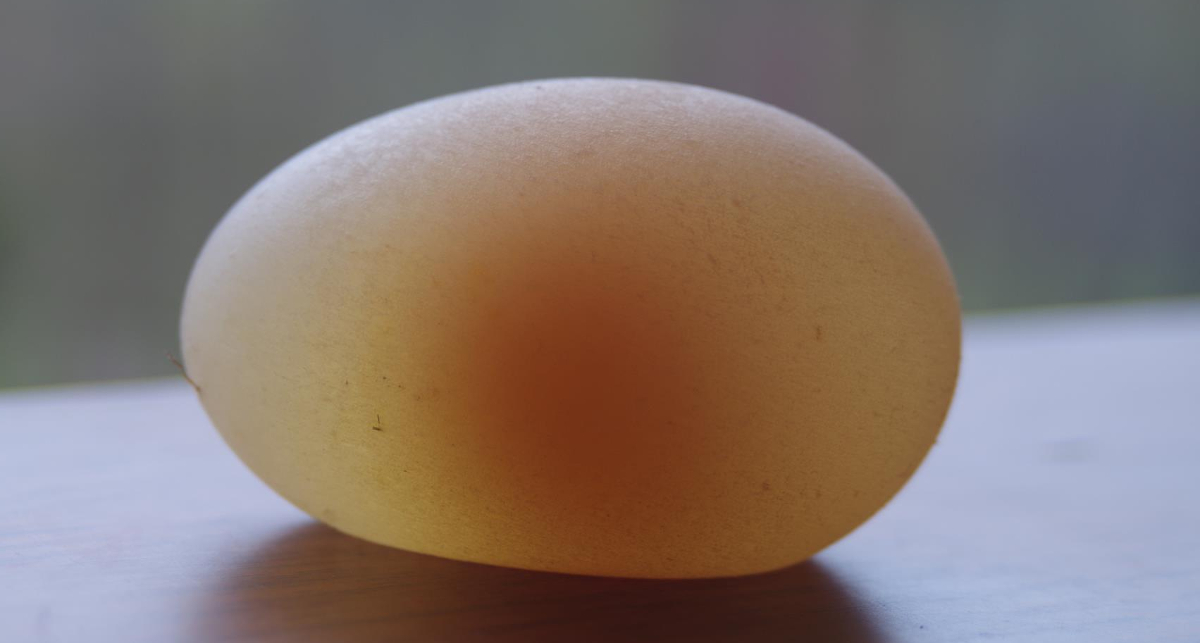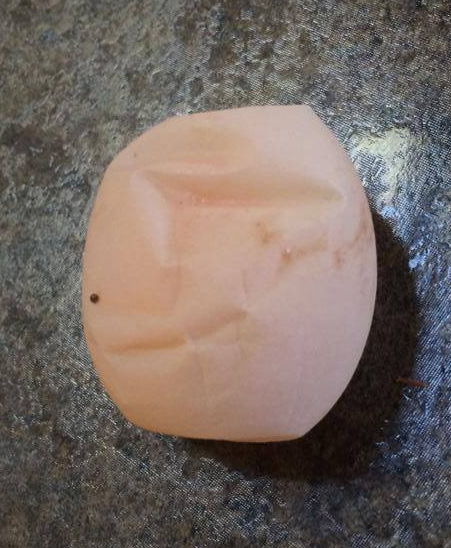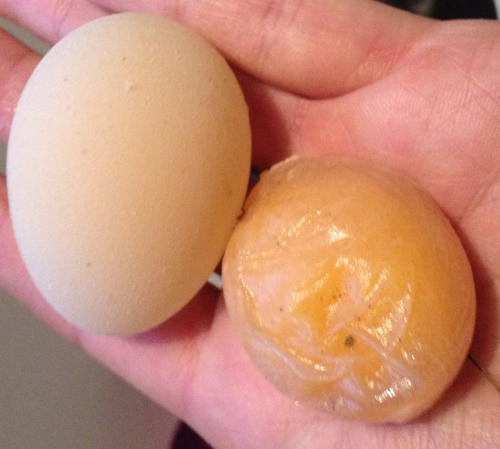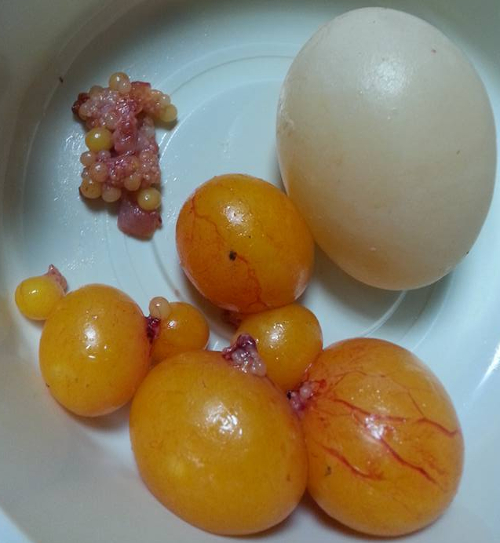Why are my chickens laying soft or thin-shelled eggs?

Thin and soft shelled eggs rightly cause concern among backyard chicken keepers as they can be an indication that something is wrong with one or more of your chickens.
Table of Contents
- Why do hens lay thin-shelled or no-shelled eggs?
- Calcium shortage in the chickens diet:
- Nutrient absorption issues:
- Too much ACV or Apple cider Vinegar.
- Young birds first eggs.
- Old chickens are known to lay more soft shelled eggs.
- Hot weather. Summer heat is the most probable cause.
- Stress.
- The bird may be sick:
- Too much protein in the diet.
- Egg drop syndrome (EDS):
- Highly productive breeds or hybrids are more prone to laying soft shelled eggs.
- Nutritional deficiencies.
- How do you stop hens laying soft shelled eggs?
- Can you eat a soft shelled egg?
- Process of egg formation:
- Egg and laying facts:
Some soft shelled egg problems can be dealt with by the keeper and some need treating by a vet.
Why do hens lay thin-shelled or no-shelled eggs?
If one or more of your hens has been laying thin or soft-shelled eggs that feel rubbery to pick up and are semitransparent so you can see the yolk then you may have a problem with the diet or the condition you are keeping your chickens in.
The occasional soft egg shell isn’t a cause for concern especially in the heat of summer just something to watch out for.
Thin or soft shelled eggs are caused by:
| Reason | How to Remedy |
|---|---|
| Calcium deficiency | Provide a source of calcium, such as oyster shells or crushed eggshells. |
| Vitamin D deficiency | Provide a source of vitamin D, such as sunlight or a supplement. |
| Stress | Reduce stress in the chicken coop by providing a quiet, safe environment. |
| Illness | Treat any underlying illness. |
| Age | A young birds first eggs may have missing or soft shells. Older hens may lay eggs with no shells as part of the natural ageing process. |
| Genetics | Some breeds of chickens are more prone to laying eggs with no shells. |
| Disease | Some diseases, such as Marek's disease, can cause chickens to lay eggs with no shells. Egg Drop Syndrome is another cause. |
| Parasites | Some parasites, such as coccidiosis, can cause chickens to lay eggs with no shells. |
| Medications | Some medications, such as antibiotics, can cause chickens to lay eggs with no shells. |
| Diet | A diet that is too high in protein or too low in calcium can cause chickens to lay eggs with no shells. |
| Moulting | During moulting, chickens lose their feathers and stop laying eggs. Some chickens may lay eggs with no shells during this time. |
| Egg binding | Egg binding is a condition that occurs when a chicken is unable to lay an egg. This can cause the egg to become stuck in the chicken's oviduct and can lead to the chicken laying an egg with no shell. |
| Too much ACV or Apple cider Vinegar in the water | ACV is an occasional use supplement. |
| Unbalanced feed ration or Nutritional deficiencies. . | Too high a protein level can produce soft shelled eggs |
If it is one bird laying a soft or thin shelled egg then it is more likely that there is something wrong with the one bird. This happens when you get one soft shelled egg at a time.
If it is more than one hen laying soft shelled eggs then it is more likely the diet, a disease or conditions affecting the whole flock. This is when you get many soft eggs at a time.
The process of egg shell formation takes up to 19 hours and is characterised by the secretion of an organic matrix of glycoproteins and mucopolysaccharides which becomes calcified to form the egg shell. This process can occasionally get upset leading to egg problems.
Below: Soft-shelled eggs are easily damaged as they are laid.

Modern hybrid laying hens can produce more than 300 eggs per year and this would not be possible without continuous ovulation.
Calcium shortage in the chickens diet:
Calcium carbonate is the main composition of the egg shell, constituting approximately 95 per cent of the shell. The egg stays in this gland for 19 to 20 hours and shell colour is also added at this point. After shell formation the egg moves into the cloaca where it is ready for lay- through the vent.
Below: Shell-less eggs can be just yolk in the membranes with no white at all.

Nutritional deficiencies of calcium, phosphorous, selenium, vitamin D, E and B 12 may also lead to thin shelled or shell-less eggs. Excessive consumption of calcium and phosphorous may on the other hand lead to abnormally thick and rough shelled eggs. Pimpled or rough eggs also occur when a shell is retained for too long in the shell gland.
Nutrient absorption issues:
Infestations of mites or worms in the gut can deprive chickens of the nutrients they need to produce eggs. Old or stale feed may have lost some of it's nutrient value. Egg production is a complex mix of hormones and processes within the body.
Within 11-15 hours 2.0-2.5 g of calcium are deposited in the eggshell. Two third of the daily calcium requirement is derived from intestinal resorption the remaining third is mobilised from unique bone structures called the medullary bone. This bone compartment is restored during the periods between eggshell formation.
As in mammals, calcium homeostasis is regulated by vitamin D3 and parathyroid hormone.
The egg shell itself is a complex mix of protein fibres and calcium deposits.
Too much ACV or Apple cider Vinegar.
We all know there are many benefits to Apple Cider Vinegar and I make a pointy of using it one day a week during the laying season. It is an acid an can affect calcium availability and adsorption in the gut.
If you have chickens laying soft-shelled or shell-less eggs, then reduce your use of Apple Cider Vinegar for a few weeks to see if it rectifies the situation. Also make sure it is never stronger than 2% in the water, it is a supplement and not a feed.
Young birds first eggs.
Young chickens just getting into the swing of producing eggs often lay very small eggs without yolks or eggs without a shell. This is quite common and in my experience it happens in about 1 in 12 birds.
It can happen because the keeper waited a bit long to switch the hen from growers ration to layer feed.
Hybrids should be on Layer feed by week 16 in preparation for laying from week 19. Heritage and rare breeds should be on layers ration from week 22. This should give them 3 full weeks at least to build their reserves.
Chickens have a unique bone structure especially for calcium storage, called the medullary bone. It can store 12% of the weight of the skeleton of the chicken and it is from this reserve that around 40% of the calcium for each and every egg shell comes.
Young hens laying soft or thin shelled eggs is normally a problem that corrects itself after a maximum of 3 eggs or so.
Old chickens are known to lay more soft shelled eggs.
Biological processes slow down as chickens age and this means that chickens, especially high production hybrids, begin to lay thinner and thinner shelled eggs and may stop laying proper eggs completely.
Below: a rubbery egg with no shell.

This is one of the reasons that commercial hens are seldom kept after 80 weeks in production. They are known in the industry as "Spent Hens" and it does describe them well.
Make sure older hens have access to extra oyster shell.
Hot weather. Summer heat is the most probable cause.
Chickens eat less when it is very warm and drink more and high temperatures cause stress. All of which contribute to soft and thin shelled eggs.
Stress.
A common sign of stress I have found is soft or thin shelled egg laid on the floor of the hen house overnight. I have had this happen during bad thunderstorms or if predators are prowling and disturbing the hens.
Cramped conditions and fighting hens or too many cockerels in the flock are others.
The bird may be sick:
Some of the defects observed in eggs may be caused by diseases, nutritional deficiencies or conditions affecting the reproductive system. Infectious bronchitis (IB) is one of the diseases that leads to production of poor quality eggs. It affects the respiratory, urinary and reproductive systems.
Any condition that affects the function of osteoblasts (bone cells) means the chicken may not be able to finds the calcium to produce a proper egg shell and conditions that affect the bowel will cause nutrient issues.
Too much protein in the diet.
Diet needs to be balanced and too many treats like Mealworm can upset the delicate balance required to produce good eggs. I have seen this happen when to much spent barley from brewing was used to feed laying hens.
Egg drop syndrome (EDS):
Egg drop syndrome (EDS) is a disease that is characterised by production of soft shelled and shell-less eggs as well in apparently healthy birds and is caused by a viral infection in laying hens. It leads to a sudden drop of around 10-40% in recorded egg production or a failure to achieve a normal peak in production.
It can be difficult to identify the disease in the early stages as hens might eat the shell-less eggs, and the only evidence that may remain is the membranes, which is a sign that is easy to miss.
Clinical signs include diarrhoea and a loss of shell colour and egg yolk pigment prior to the production of soft-shelled eggs and mortality is usually negligible.
Ducks and geese are the natural hosts for the EDS virus and are asymptomatic carriers. Chickens of all ages and breeds are susceptible but the disease is most severe in broiler breeders and brown-egg layer strains. EDS was first introduced into chickens through contaminated vaccine and spread through breeder flocks. EDS is a notifiable disease.
There is no successful treatment of EDS. The classical form has been eradicated from primary breeders and the maintenance of EDS-free breeding stock is the main control measure.
In layers, induced moulting will restore egg production after an episode of EDS infection.
Highly productive breeds or hybrids are more prone to laying soft shelled eggs.
The modern hybrid easily lay 300 eggs a year and in the commercial environment special feed additives.
Nutritional deficiencies.
Old or stale feed can lose nutritional value and diet that consist of too much wheat or barley
How do you stop hens laying soft shelled eggs?
The treatment for soft or no shelled eggs is to reduce stress and improve the diet.
- Boost the calcium in the diet by feeding their eggshells back to them after roasting and crushing.
- Diatomaceous earth is good for the long term treatment of parasites and makes an excellent supplement for improving egg production - Using DE for chickens.
- Provide shade and fresh clean cold water in hot weather.
- Treat hens regularly for Coccidiosis and parasites.
- Feed fresh food in a balanced diet and make sure birds have access to fresh greens and pasture.
- Keep heritage breeds, they lay eggs with stronger and thicker shell as a rule than hybrids.
- The ultimate treatment for a chicken laying soft or shell-less eggs is a forced moult.
Soft shelled eggs are more likely to get stuck in chicken or burst during the laying process which brings it's own set of problems.
Can you eat a soft shelled egg?
You may be able to handle a soft-shelled egg without breaking it and cook it as well but if there is something wrong with your hen I would not eat the egg. Also the shells stop bacteria contaminating the insides of the egg.
So yes you probably can eat a thin shelled or no shell eggs if you don't keep it for any length of time and cook it well but my personal choice is that I would not.
Process of egg formation:
It takes the hen approximately 24 to 26 hours to develop and lay an egg. This process takes place in stages. Production of the yolk is the commencing stage. The ovary produces thousands of ova which become future yolk. The ova begin to develop one at a time when the hen reaches sexual maturity. In hens, only one ovary is active — the left ovary.
Below: Many yolks are in the process of being formed at any one time.

During ovulation, the yolk is released into a funnel shaped structure known as the infundibulum- a part of the oviduct. Ovulation/release of the yolk normally occurs approximately 15 to 30 minutes after laying of the previous egg.
In some cases two yolks are released at the same time, leading to a double yolked egg. This is mostly seen in young or old chickens or those that lay big eggs.
Blood spots are occasionally observed in the yolk. These may be due to ruptured blood vessels especially capillaries during ovulation or in the oviduct.
Fertilisation usually occurs in the infundibulum (as long as insemination had occurred). The released yolk travels down to the magnum - 2nd part of the oviduct where the egg white (albumen) is added.
This takes up to three hours. Foreign material in the oviduct may end up being incorporated in the egg for instance round worms. The next process takes place in the isthmus- the 3rd part of the oviduct.
Here, the egg membranes that are found around the egg white are formed as well as addition of water to the egg white. The egg at this juncture has all its components and necessary nutrients and is ready for shell formation. The process of shelling takes place in the shell gland (uterus). Salt and water are added to the egg before calcification (shell formation) takes place.
Egg and laying facts:
Layers producing 300 eggs per year require nearly 1.8 kg of calcium matching their own body weight
A consequence of the high ovulatory rate in layers is the frequent formation of ovarian tumours. 30-35% of hens older than 2.5 years develop adenocarcinomas.
Yolk formation is completed 24 hours before ovulation.
The ovulation cycle takes nearly 24 hours in modern layer lines while it may take up to 27 hours in low producers.
Yolk contains approximately 36% lipids, 17% protein (largely immunoglobulins) and only a minor fraction of free carbohydrates and inorganic components (<1%), the rest is water.
In the ovary of newly hatched hens more than 12.000 oocytes are present. Of these, only a small proportion will later acquire yolk and develop into mature ovulatory oocytes.
